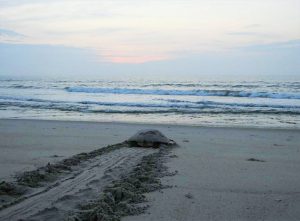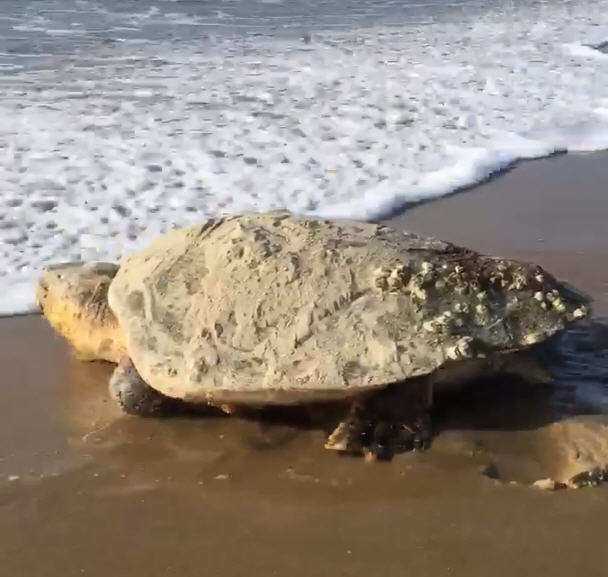Early on Wednesday morning, Cape Hatteras National Seashore staff caught video footage of a loggerhead sea turtle returning to the ocean after nesting on the shoreline, per a recent social media update.
The loggerhead sea turtle is the primary nester on Hatteras and Ocracoke islands, although the isolated beaches also attract a few green turtles and an occasional leatherback or Kemp’s Ridley sea turtle.
Although sea turtles live most of their lives in the ocean, adult females will return to land to lay their eggs, and often migrate long distances between foraging grounds and nesting beaches.

Loggerheads nest every 2-3 years, and will lay an average of four clutches per year. Sea turtles nest on sandy beaches at night, with the majority of nesting occurring from May through September. The 100 or so eggs in the nest will incubate for approximately 60 days, with the temperature of the sand determining the gender of the hatchlings – warmer sand will develop mostly females, cooler sand produces mostly males.
As Hatteras and Ocracoke islands are at the beginning of the sea turtle nesting season, CHNS also shared tips for beachgoers in a recent update to ensure that nesting turtles remain safe throughout the summer.
- During sea turtle nesting season, (May through October), items left on the beach can cause disturbances that may deter a nesting female from laying her eggs, or which may cause entanglement which compromises the health of the turtle. Specific items of concern include chairs, canopies, volleyball nets, and fishing equipment.
Any obstacles that sea turtles face on the beach have the potential to alter their perception of the nesting habitat and they may decide to nest elsewhere, or the nest may be laid too close to the water’s edge.
- Be sure to put out any beach fires with sufficient water; fires left burning and unattended may cause harm to the nesting females.
- Items left overnight on the beach are considered abandoned and are subject to removal if determined to directly alter the behavior of wildlife (i.e. sea turtles) and/or the safety of visitors.
- In addition to the impacts listed above, large holes left in the beach pose a danger to nesting sea turtles and humans walking on the beach at night.
- Be considerate of other visitors and respect wildlife are part of the seven principles of the Leave No Trace program. https://www.nps.gov/…/planyourvi…/packitinpackitout.htm
Sea turtle nests laid by loggerheads, green turtles and leatherbacks have been monitored at CHNS since the 1970s. In 2015, a nesting record of 289 nests was set, followed by a new record in 2016 when 325 sea turtle nests were recorded along the CHNS beaches.
In 2019, there were a total of 473 sea turtle nests recorded within the National Seashore, which blew the previous record of 325 out of the water.
The high number of sea turtle nests in recent years appears to be a multiple-year trend all along the Eastern Seaboard, according to data from seaturtle.org, which actively monitors sea turtle nests all around the globe.
Due to the recent highly active nesting seasons, visitors are advised to be aware of sea turtle nesting activity or hatchlings while visiting the local beaches on Hatteras and Ocracoke islands.
If you see turtle tracks, nesting activity, or hatchlings, please notify park biologists by calling the hotline at 252-216-6892.
In the meantime, visitors can keep tabs on nesting activity at shorelines all around the world at http://www.seaturtle.org.


